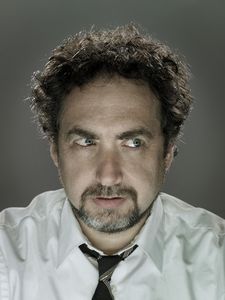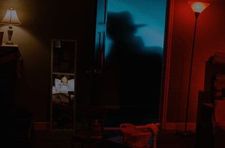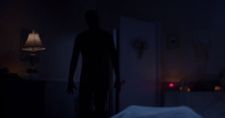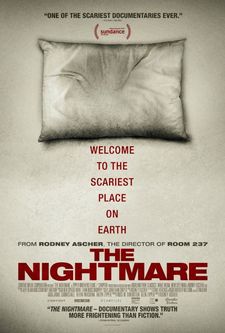 |
| Rodney Ascher |
It’s sometimes said that what people find really scary in film depends on their personal experience. The Nightmare – actually documentary rather than horror per se – examines an experience that some 30% of people share, yet which is so little talked about that many of them think they’re alone. Sleep paralysis leaves people trapped in their beds, unable to move, whilst many find themselves observing terrifying things. Nobody is entirely sure what this experience means ad Rodney Ascher made his film in the hopes of starting a conversation that could lead to it being better understood.
“I’ve been interested in this subject for a long time, ever since it happened to me years ago,” he explains. “After I made Room 237 I wanted to do another documentary that also played off genres against each other. This topic is both something that I think is criminally under-discussed given how common it is, and naturally dramatic. I found so many people with such interesting stories and it was a world I knew I would be happy to explore.”
The documentary follows the stories of eight individuals who talk about their experiences and how sleep paralysis has impacted their lives. How did Rodney settle on those eight? How did he decide which stories to include and which to set aside?
“It was hard,” he says, “because in a way I had an embarrassment of riches. There were so many people sharing stories online and so many approached me after I put up a request. I spent close to a year thinking about and researching stories. At first they did seem to break down into categories. I wanted to get a representative sample so I’d have someone who has out of body experiences, someone who sees the hat man [a sinister figure reported to approach sufferers whilst they are unable to move], someone who sees someone else. As a general rule of thumb I wanted to have strong representation of a multitude of experiences, but once I got into it I fund they didn’t really fit into categories at all, at least not in a way that was tidy. So it largely came down to how articulate they were and how introspective, and how powerful their stories were. Inevitably some of it also came down to logistics and where we could manage to travel, which is why some of them are near to each other.”
Did his own experience resemble those of the people he interviewed? I ask hesitantly, knowing he might not want to talk about it, but he seems comfortable doing so, in part because it’s not something he has to deal with anymore.
 |
| The hat man cometh |
“It was simpler than many of the others had,” he says. “I was frozen in bed and I saw the shadow man leaning over me. I’ve never been as frightened in my life. I was unaware of sleep paralysis as a condition so I didn’t know what was happening. I had never heard of it before.”
The shadow man is another of the figures whom sufferers commonly describe. All the figures in these dreams (or whatever they are) seem to have a shadowy form. But why do so many different people – all over the world – see the same things?
“That’s the biggest question I take out of this from a medical and psychological perspective on dream states and why we dream the things that we do,” he says. “I’ve come across a couple of notions but to be honest they sound pretty speculative. If you avoid supernatural explanations, which many people who go through it don’t, then you get to Jungian ideas about archetypes and the collective unconsciousness. One idea that I’m quite attracted to is about how infants see the world in black and white to begin with, because people see these silhouetted characters, so maybe there’s some kind of stimulation of old memories of parents leaning over the crib.”
We discuss my own experiences of sleep paralysis and I explain that, although other elements still made the experience horrible for me, I at least had the advantage of having heard of the phenomenon before it happened to me, so I didn’t think I was having a stroke or dying as many other sufferers do. I was also fortunate in that I didn’t experience pain like one of the contributors to the film. Rodney says he had never heard of pain being a factor until he came across that case, and there’s a shudder in his voice that suggests he, too, feels he was lucky in that regard. It was one of a number of new discoveries he made when working on the film, and he remains just as interested in the subject now, saying that he continues to come across new explanations for it.
 |
| Beware the shadow man |
“I’m also interested in the different places that people’s struggles to understand and research mysteries take them,” he says. “Whether it’s sleep paralysis or The Shining, these things offer windows into the way people figure out mysteries.”
So with all this thinking going on, why does he think people are so reluctant to talk about it? “The two most obvious explanations are the supernatural or hallucinations and both of them carry a heavy stigma,” he says. “One thing I heard is that people talk about it less in the US and I presume in the UK but in Asia they talk about it a lot more so it’s probably very different.” Other cultures, he notes., consider experiences like this to have important spiritual meaning and talk about them to try and learn from them.
Something that I hadn’t come across until I watched his film, I tell him, is the idea that the concept of sleep paralysis can be infectious, with those who have heard about it more likely to start suffering from it. Did this give him any moral qualms about making the film?
He laughs, but acknowledges the darkness inherent in that possibility.
“On the one hand I genuinely don’t want people to go through a horrible experience like that after seeing the movie but on the other there’s a proud tradition of horror movies giving out warnings that they could be too upsetting for people, and there are old ideas about terrors that emerge from the screen. Making a film takes you in different directions. When I was with the interviewees I would feel very empathetic and supportive but then when I was filming the re-enactments I had to be more sadistic. I think we all have those contradictions in us.”
 |
| The Nightmare poster |
Did the interviewees see or participate in the making of the re-enactments? No, he says. They mostly lived too far away, except for one, Forrest, who did visit the set. The others will see their experiences recreated for the first time when watching the film in cinemas, if they feel brave enough to go.
What’s next for him? “I’m currently exploring a bunch of different things but I’m particularly interested in blurring the lines between genres,” he says. And his hopes are high for the future of The Nightmare.
“It’s come out in the US already and I’m perfectly satisfied that it’s helped start a bigger conversation about sleep paralysis. I hear every day now from more people who have gone through it. I thought it might be upsetting but it seems that most of them found it helpful to have their experience reflected back at them. I had a really interesting conversation recently about the relationship between dreams, sleep paralysis, horror and folklore. One of the reasons I made the movie was to start conversations and I’ve enjoyed seeing how they go after it ends. I had no idea that the most common experience for people who’ve been through this and were watching it would be relief.”
About half the people he’s talked to about the condition, no longer experience it, he tells me – they seem to have aged out of it. It’s most common in teenagers and young adults, which some people have suggested points to a hormonal trigger. But the quest for more understanding is ongoing.
“There’s a book that’s come out recently called Sleep Paralysis, by Brian Sharpless,” he says – a recommendation for those interested in learning more themselves. He’s also started seeing more articles about it in magazines and newspapers. So are we on the edge of a breakthrough, if lots of people are getting interested in it at once?
“Perhaps,” he says. “Sometimes there’s something in the air.”
The Nightmare is in cinemas now and comes out on DVD on October 26.





















